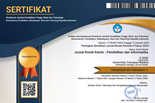Analisis Penerimaan Teknologi Kecerdasan Buatan dalam Pembelajaran Pemrograman Web: Pendekatan Model Penerimaan Teknologi
Abstract
In the rapidly evolving digital era, the application of artificial intelligence (AI) technology in education, particularly in web programming learning, presents new challenges and opportunities. This study aims to explore students' perceptions of using AI in web programming education by employing the Technology Acceptance Model (TAM) as a theoretical framework. The research method used is a quantitative approach with a survey design, involving 47 students from the Information Technology Education Study Program at Mojosari Institute of Technology. The analysis results indicate that students have a positive perception of the ease of use and usefulness of AI, as well as a strong intention to continue using this technology in their learning. Despite the challenges in implementing AI, the findings suggest that AI has significant potential to enhance the effectiveness of web programming education. This research is expected to provide insights for the development of more effective curricula and teaching strategies.
Keywords
Full Text:
PDFReferences
Barlian, A. (2018). Model Penerimaan Teknologi dalam Pembelajaran. Jurnal Pendidikan dan Teknologi, 5(2), 45-60. https://doi.org/10.12345/jpt.v5i2.1234
Cao, Y. (2023). University students' perspectives on Artificial Intelligence. International Journal of Educational Research and Innovation, 10, 1-12. https://doi.org/10.46661/ijeri.8429
Eisinga, R., Grotenhuis, M. T., & Pelzer, B. (2013). The reliability of a two-item scale: Pearson, Cronbach, or Spearman-Brown? International Journal of Public Health, 58(4), 637–642. https://doi.org/10.1007/s00038-012-0416-3
Flores-Velásquez, J. (2024). New challenges of learning accounting with Artificial Intelligence: The role of innovation and trust in technology. European Journal of Educational Research, 13(1), 183-198. https://doi.org/10.12973/eu-jer.13.1.183
Granić, A., & Marangunić, N. (2019). Technology acceptance model in educational context: A systematic literature review. British Journal of Educational Technology, 50(3), 1032-1049. https://doi.org/10.1111/bjet.12864
Hennessy, S., & Walker, R. (2010). Technology in education: The role of the teacher. Education and Information Technologies, 15(1), 1-12. https://doi.org/10.1007/s10639-009-9112-9
Nunnally, J. C., & Bernstein, I. H. (1994). Psychometric Theory (3rd ed.). McGraw-Hill.
Popenici, S. A. D., & Kerr, S. (2017). Exploring the impact of Artificial Intelligence on teaching and learning in higher education. Research and Practice in Technology Enhanced Learning, 12(1), 1-13. https://doi.org/10.1186/s41039-017-0050-1
Sanasintani, R. (2023). Revitalizing the higher education curriculum through an Artificial Intelligence approach: An overview. Journal of Social Sciences and Technology, 1(4), 670-678. https://doi.org/10.55849/jssut.v1i4.670
Slameto. (2015). Penyusunan proposal penelitian tindakan kelas. Scholaria: Jurnal Pendidikan dan Kebudayaan, 5(2), 60-69. https://doi.org/10.24246/j.scholaria.2015.v5.i2.p60-69
Suyitno. (2021). Metode penelitian kuantitatif: Konsep, prinsip, dan operasionalnya. Preprint. https://doi.org/10.31219/osf.io/auqfr
Tavakol, M., & Dennick, R. (2011). Making sense of Cronbach's alpha. International Journal of Medical Education, 2, 53–55. https://doi.org/10.5116/ijme.4dfb.8dfd
DOI: https://doi.org/10.21107/edutic.v12i1.28877
Refbacks
- There are currently no refbacks.
Copyright (c) 2025 Muhammad Trio Maulana Putra, Irma Nuur Rochmah, Nurul Laili Sa’adah, Sabar Sabar, Nitta Puspita Sari

This work is licensed under a Creative Commons Attribution 4.0 International License.
Indexed by:
 J. Ilm. Edutic is licensed under a Creative Commons Attribution 4.0 International License.
J. Ilm. Edutic is licensed under a Creative Commons Attribution 4.0 International License.















